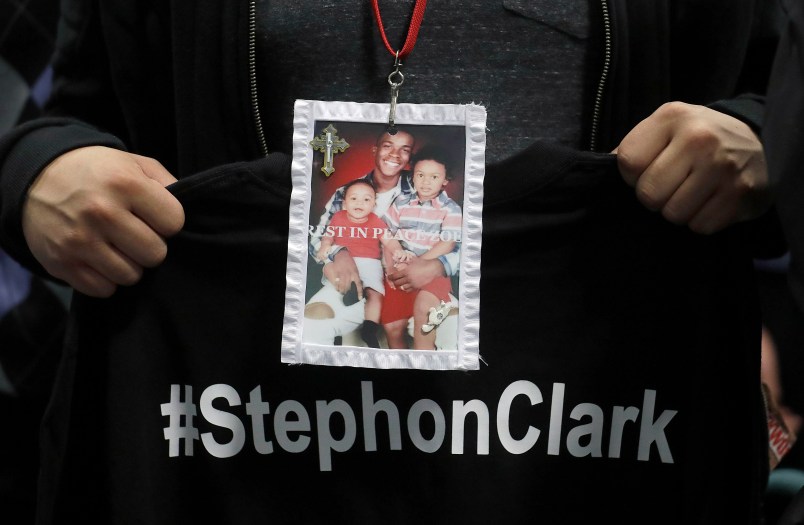SACRAMENTO, Calif. (AP) — California’s attorney general said Tuesday that he won’t charge two Sacramento police officers who fatally shot an unarmed black man last year, a killing that set off intense protests.
Attorney General Xavier Becerra’s announcement follows the Sacramento district attorney’s finding this weekend that the two officers broke no laws when they shot 22-year-old Stephon Clark.
Officers Terrance Mercadal and Jared Robinet say they mistakenly thought Clark was approaching them with a gun after he ran from them into his grandparents’ backyard as police investigated vandalism.
Becerra said his review found officers believed Clark was armed and their lives were in danger when they opened fire. Investigators found only a cellphone.
“Based on our review of the facts and evidence in relation to the law, I’m here to announce today that our investigation has concluded that no criminal charges against the officers involved in the shooting can be sustained,” Becerra said.
The attorney general emphasized the need for changes and called Clark’s killing a “devastating loss.” He met with Clark’s mother, SeQuette Clark, before announcing his decision. Jamilia Land, a family spokesperson, said SeQuette Clark would speak to reporters later Tuesday.
Clark was shot seven times on March 18, 2018, and his killing prompted protests in California’s capital city and across the U.S.
Sacramento County District Attorney Anne Marie Schubert’s decision not to charge the officers has sparked new demonstrations, with more than 80 people arrested Monday in a wealthy Sacramento neighborhood.
Clark’s family and black community leaders urged Becerra to reach a different conclusion.
“I would like for the attorney general to prosecute the officers,” brother Stevante Clark said Sunday. “I want justice and accountability.”
Both Becerra and Schubert concluded that the officers feared for their lives when they shot Clark, who they thought was holding a gun. They were pursuing him after receiving calls about someone breaking car windows.
The attorney general and district attorney said the evidence showed Clark was advancing toward the officers when they shot him.
The decision has increased support from top state officials to change California’s legal standard for when police can use deadly force.
Lawmakers have revived a measure introduced after Clark’s slaying that would make California the first state to allow police to use deadly force only when it’s necessary to prevent imminent and serious injury or death and if there’s no reasonable alternative, such as warnings or other methods.
Strong opposition from law enforcement agencies stalled it last year.







“Becerra said his review found officers believed Clark was armed and their lives were in danger when they opened fire.”
That’s what they said. Is there any proof of it? Is there evidence that they were acting in good faith? Or was it an excuse to shoot someone?
And why isn’t this something that a jury should decide?
In order to charge someone with a crime, you need to define the culpable mind state. Accidentally shooting someone, or shooting someone when you think it’s authorized, but later deemed a mistake is of itself not a crime. Prosecutors need to show either bad intent, recklessness or grave indifference. What the AG is saying, is while the case is most tragic, this was caused by human error.
The family will have to seek its closure from Civil courts who have a different standard and ways to recoup the loss.
I rewatched the video yesterday. The characterization of Clark as “advancing toward the officers” is a gross mischaracterization. The officers are at the corner of the house, not exposed. Clark is against the wall, about 30 feet away.
Within one second, an officer shouts “show me your hands, gun gun gun!”, Clark takes two or three steps toward them, the officers fire five shots, Clark drops to his hands and knees. The officers pause for a second or two, then fire 15 more shots.
The characterization is highly questionable for the first five shots. It is completely and absolutely false for the last 15 shots.
I am really starting to think cops should not be able to shoot until they are shot out. They seem to be terrible at identifying when someone is really got a gun, granted it’s mostly with the suspect isn’t white.
I agree. Far too many LEOs are cowards. Far too many think their lives are more valuable than others.
They should also be forced to leave the job once they’ve fired their weapon in the line of duty. They’ll think twice about shooting if they know it will cost them their job. Whether the shooting is later deemed justifiable or not, you can no longer be a police officer once you’ve fired your weapon at someone.
When I worked with military police, I was told that if I pulled my weapon and did NOT shoot someone, I would go to jail. “You do not pull your weapon to threaten. You do not fire warning shots. You leave that weapon in its holster until you feel you must shoot someone to protect yourself or others. And if you do shoot at someone, you aim for center mass”.
There’s no such thing as “shooting to maim”.